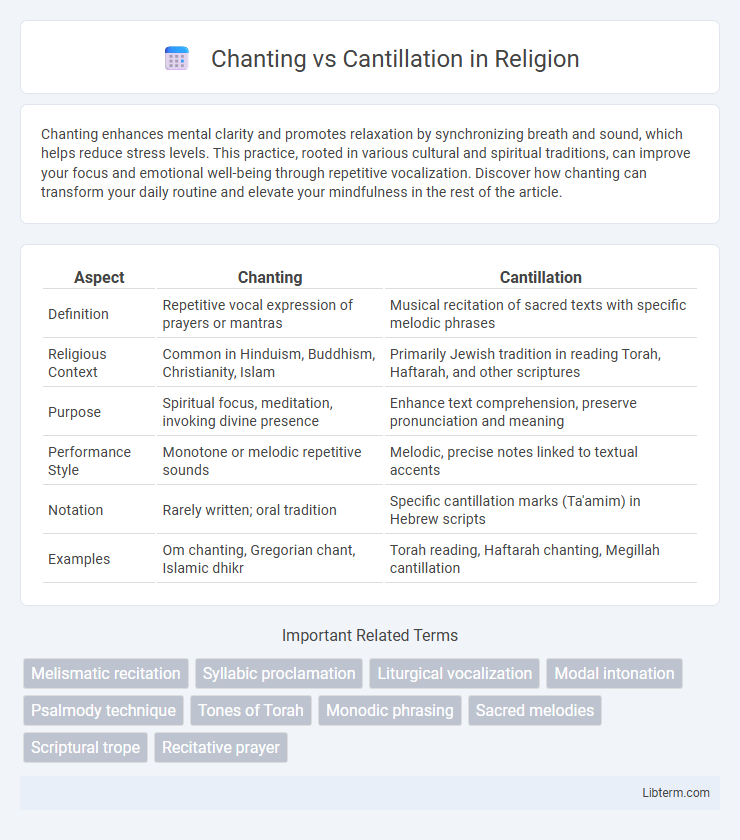Chanting enhances mental clarity and promotes relaxation by synchronizing breath and sound, which helps reduce stress levels. This practice, rooted in various cultural and spiritual traditions, can improve your focus and emotional well-being through repetitive vocalization. Discover how chanting can transform your daily routine and elevate your mindfulness in the rest of the article.
Table of Comparison
| Aspect | Chanting | Cantillation |
|---|---|---|
| Definition | Repetitive vocal expression of prayers or mantras | Musical recitation of sacred texts with specific melodic phrases |
| Religious Context | Common in Hinduism, Buddhism, Christianity, Islam | Primarily Jewish tradition in reading Torah, Haftarah, and other scriptures |
| Purpose | Spiritual focus, meditation, invoking divine presence | Enhance text comprehension, preserve pronunciation and meaning |
| Performance Style | Monotone or melodic repetitive sounds | Melodic, precise notes linked to textual accents |
| Notation | Rarely written; oral tradition | Specific cantillation marks (Ta'amim) in Hebrew scripts |
| Examples | Om chanting, Gregorian chant, Islamic dhikr | Torah reading, Haftarah chanting, Megillah cantillation |
Introduction to Chanting and Cantillation
Chanting is the melodic vocalization of sacred texts, often characterized by repetitive and rhythmic tones to enhance spiritual connection and memorization. Cantillation refers specifically to the ritualized chanting of scriptural readings, particularly in Jewish tradition, where precise musical motifs guide the pronunciation and interpretation of the Torah. Both practices serve to transmit religious teachings orally, but cantillation emphasizes detailed melodic punctuation to preserve textual meaning.
Historical Origins of Chanting and Cantillation
Chanting originates from ancient religious practices, notably in Hindu Vedic traditions and early Christian liturgies, serving as a means to preserve sacred texts through melodic intonation. Cantillation, distinctively developed within Jewish tradition, involves specific melodic motifs used to chant Torah and biblical readings, aiding in textual interpretation and memorization. Both practices share roots in oral tradition but diverged historically through their cultural and religious contexts, reflecting unique purposes and styles of vocal expression.
Defining Chanting: Techniques and Traditions
Chanting involves the melodic recitation of religious texts, using controlled vocal techniques that emphasize sustained tones, rhythmic patterns, and variations in pitch to evoke spiritual ambiance. Techniques include breath control, phrasing, and ornamentation, with traditions differing across cultures such as Gregorian chant in Christianity and Vedic chanting in Hinduism. These methods serve not only to preserve sacred scriptures but also to enhance communal worship and meditative practices.
Understanding Cantillation: Purpose and Practice
Cantillation refers to the melodic chanting of biblical texts, primarily in Jewish liturgy, serving as a guide for proper pronunciation, phrasing, and interpretation. Its purpose is to convey the sacred text's meaning through specific musical motifs, enhancing comprehension and spiritual engagement. Practiced by trained readers termed ba'alei ta'amim, cantillation employs a system of symbols called trope marks that dictate tone and rhythm.
Key Differences Between Chanting and Cantillation
Chanting involves melodic vocalization of religious or spiritual texts often without strict notation, emphasizing repetitive and meditative patterns. Cantillation specifically refers to the ritualistic chanting of scripture with precise musical phrases guided by traditional marks or symbols, especially in Jewish and some Christian liturgies. Key differences include the level of structure, with cantillation requiring exact tunes linked to textual accents, whereas chanting offers more flexibility in melody and rhythm.
Cultural and Religious Contexts
Chanting in religious and cultural contexts often involves repetitive, melodic vocalization used for meditation, prayer, or spiritual connection across traditions like Hinduism, Buddhism, and Christianity. Cantillation specifically refers to the ritual chanting of scripture with melodic phrases, prominent in Jewish synagogue services for Torah and Haftarah readings. Both practices enhance communal worship and preserve ancient oral traditions, yet chanting emphasizes devotional immersion while cantillation focuses on precise scriptural articulation and interpretation.
Musical Notation and Patterns
Chanting and cantillation both involve vocal musical traditions, but differ in their use of musical notation and melodic patterns. Chanting typically follows a more fluid, modal system without fixed notation, relying on oral transmission and improvisation within established scales. Cantillation employs precise melodic motifs linked to textual punctuation, often represented through specialized marks or symbols indicating exact pitch and rhythm essential for liturgical recitations.
Roles in Worship and Ritual
Chanting serves as a meditative vocal practice that enhances spiritual connection during worship, often involving repetitive mantras or prayers to create a sacred atmosphere. Cantillation, specifically tied to the chanting of scripture, uses precise melodic notations to guide the recitation of sacred texts, ensuring accurate transmission and interpretation. Both roles are integral in rituals, with chanting fostering communal devotion and cantillation preserving the textual sanctity within liturgical traditions.
Psychological and Spiritual Effects
Chanting enhances psychological well-being by promoting relaxation, reducing stress, and fostering a meditative state that supports emotional balance. Cantillation, with its precise melodic patterns in religious texts, deepens spiritual connection and aids memorization, reinforcing faith and communal identity. Both practices activate neurobiological pathways that contribute to heightened awareness and inner peace.
Modern Adaptations and Contemporary Relevance
Modern adaptations of chanting and cantillation have integrated digital technology and multimedia tools to enhance accessibility and engagement in religious and spiritual practices. Contemporary composers and practitioners experiment with blending traditional cantillation motifs with modern musical genres, fostering renewed interest and relevance in urban and interfaith contexts. These innovations support the preservation of ancient liturgical elements while making them resonate with global, diverse audiences.
Chanting Infographic

 libterm.com
libterm.com